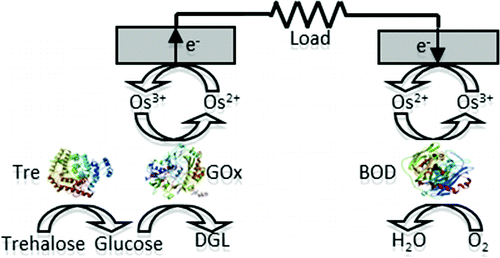Biofuel cell generates electricity when implanted in False Death's Head Cockroach

Scientists have developed and implanted into a living insect — the False Death's Head Cockroach — a miniature fuel cell that converts naturally occurring sugar in the insect and oxygen from the air into electricity. They term it an advance toward a source of electricity that could, in principle, be collected, stored and used to power sensors, cameras, microphones and a variety of other microdevices attached to the insects in a paper in the Journal of the American Chemical Society.
Daniel Scherson and colleagues explain that scientists are developing ways to generate electricity from chemicals inside living things or from their movements to power implanted sensors or other miniature devices. Such devices could provide researchers or physicians with important information about processes going on inside insects, animals or even people without the need for batteries. They also could someday power artificial organs, nanorobots or wearable personal electronics. But before such "sci-fi"-sounding advances can be realized, practical biofuel cells are necessary. That's why Scherson and colleagues developed an implantable biofuel cell for use in a live cockroach.
The biofuel cell uses a sugar in the cockroaches' bodies called trehalose and oxygen from the air to generate electricity. It did not kill the insects or impair functioning of their internal organs. They also implanted the device into a Shiitake mushroom, and it worked. Neither fuel cell — in the roach or the mushroom — produced a large amount of energy, so the team says that any microdevice that requires high power could operate only intermittently. The electricity generated by the biofuel cell, "in principle, could be collected and stored and subsequently used to power a variety of microdevices," say the researchers.
More information: An Implantable Biofuel Cell for a Live Insect, J. Am. Chem. Soc., 2012, 134 (3), pp 1458–1460. DOI:10.1021/ja210794c
Abstract
A biofuel cell incorporating a bienzymatic trehalase|glucose oxidase trehalose anode and a bilirubin oxidase dioxygen cathode using Os complexes grafted to a polymeric backbone as electron relays was designed and constructed. The specific power densities of the biofuel cell implanted in a female Blaberus discoidalis through incisions into its abdomen yielded maximum values of ca. 55 μW/cm2 at 0.2 V that decreased by only ca. 5% after ca. 2.5 h of operation.
Journal information: Journal of the American Chemical Society
Provided by American Chemical Society


















